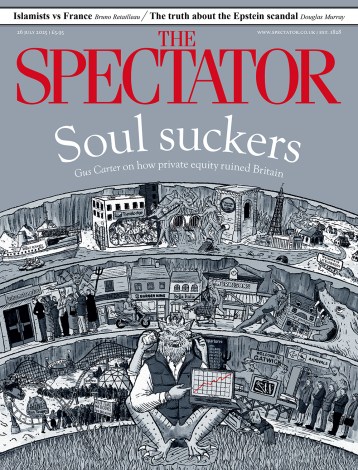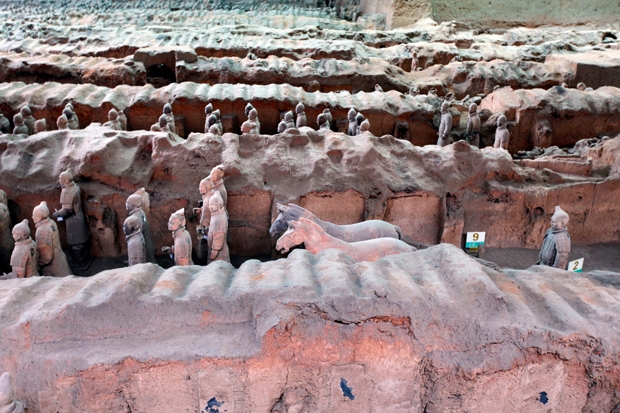Channel 4’s Kids and Guns (Thursday) began with an American TV advert in which a young boy’s eyes shone with gratitude when his parents gave him a large gun, proudly marketed as ‘My First Rifle’. And just in case that seemed a bit macho, the ad also pointed out that My First Rifle is available in pink.
Next, we met the real-life Gia, who at the age of nine already has quite an arsenal — thanks to her dad Spyder, a firm believer in the old Texan motto that ‘If you know how many guns you have, you don’t have enough’. ‘Wouldn’t it be more usual to buy her Barbie dolls?’ asked what couldn’t help but sound like a rather prissy British off-screen voice. ‘I do buy Barbie dolls,’ Spyder replied, ‘but we shoot them.’ Any ideas that he might have been joking were then dispelled by a scene featuring a series of decapitated Barbies hanging from a fence and Gia explaining, ‘I aim for the head.’
Needless to say, sneering documentaries about how nuts Americans are have been a staple of British television for decades. Yet, while this one wasn’t entirely free of the raised eyebrow, it did at least spare us the curled lip. Instead, it made a creditable attempt to show us the subject from the point of view of the people involved — who, on the whole, saw teaching children to handle guns not merely as a right, but as a sign of responsible parenting.
In fact, the more we learned, the trickier it became to view even the most gun-toting of the participants as caricatures. The sight of a girl called Kaelyn getting a huge rifle for her fourth birthday initially seemed an obvious step too far — especially once she’d reluctantly fired it, been hit on the chin by the recoil and been terrified by the noise. But then we discovered that her father JD had lost both legs and an arm in Afghanistan and was clearly trying to establish what, after a happy boyhood hunting with his own dad, he regarded as a normal family life. From there, he had several more doomed goes at interesting his daughter in heavy weaponry — before ending the programme on a chastened note. ‘I pressurised her too much, it was selfish of me,’ he said. ‘If she doesn’t want to do it, I’m not going to make her.’
Even sadder was the story of nine-year-old Hank, killed when his gun went off accidentally after he’d been allowed to hunt rabbits on his own. His mother, who’d bought him the gun, was naturally torn apart with regret. His father tearfully remembered how talkative he’d been: ‘I never thought I’d miss hearing “Hey, daddy” 500 times a day.’ Neither, though, was in favour of gun control.
Near the beginning of Thursday’s documentary, the narrator had told us how fierce the debate is in America about children and guns. Yet, as it turned out, the programme’s great strength was that this was a debate we never heard, and never needed to. The stories it brought us proved far more revealing — and startling — than any recitation of the usual arguments could ever have been.
Happily, Andrew Graham-Dixon’s The Art of China (BBC4, Wednesday) follows the same pattern as his previous ‘Arts’ of Spain, Russia, Germany and America: a thoughtful analysis of individual works combined with wider thoughts on how the country’s art has both reflected and shaped its history. Except, of course, that this time there’s a lot more history for the art to reflect and shape.
So it was that Monday’s first episode began more than 3,000 years ago, and ended several centuries before the Battle of Hastings. Among the many marvels it showed us along the way were a 35-metre-high statue of a female Buddha and those 8,000 terracotta warriors built to protect the tomb of China’s first emperor Qin Shi Huang. (After that, the burial site takes a turn for the spectacular.) It also came in handy for those of us who need to brush up on our Chinese dynasties — always useful for watching University Challenge.
Even so, what remained most striking was the astonishing continuity of Chinese history, as expressed in a written language that was already established at the time of hieroglyphs and cuneiform script but, unlike them, is still around today. To prove it, Graham-Dixon showed us the characters for ‘education’ as found on a turtle shell from 1200 BC, and as it is now. Not only do they look very similar, but they also provide something of an insight into the recent controversy about Tiger Mothers — because for more than three millennia, education has been represented in China by a boy learning maths while an adult stands over him with a big stick.






Comments